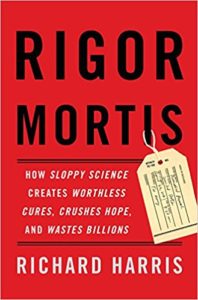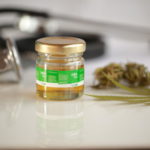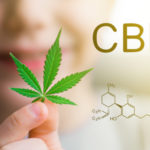Do you notice, almost daily, how one study comes out about weight loss, only to be trumped by another the very next day?
Having been formally trained as a research scientists and spending countless hours performing research, editing manuscripts, and related work, I have often found that many scientific studies are in fact bogus.
How often have you encountered a study on weight loss or burning fat that points out the great result, only to find later in the week another study that nullifies the first? You’re not alone.
In brief, many medical studies are simply bogus and even the research community has a laugh about it. They call it the reproducibility crisis. As an example of the field, if you do research and report your materials and methods, another scientist should be able to duplicate that research. However, that is rarely the case anymore.
Without that replication, the research simply has no legitimacy. When you look at the overall figures, about 50% of medical studies will have reproducibility and hold up to hard core scrutiny. This is not only true in diet, fat loss, and weight removal, but in almost every single field from engineering to global warming. If you need to lie about your data, something is wrong with it; at the very least it’s very biased. But wait, it gets worse, for studies involved in the cutting edge issues such as new genes or formulas linked to obesity or other health issues, almost 2/3 of them are later dis-confirmed.
Research itself is a trial and error process, but these types of bogus reports slow the progress of science, not to mention besmirching the reputation of good scientists who remain unbiased in their efforts. Annually, non-reproducible science cost the American tax payer about $28 billion according to NPR science correspondent Richard Harris in his book.
Advertisement: Amazon (click on photo for more info)

Harris has cautioned us to take things we read with a grain of salt. It’s sort of like the adage, ‘believe nothing that you hear and only half of what you see!’ If you are not familiar with reading scientific articles they can be misleading, especially when what you are reading is not the best science to begin with.
As an example, for many years research on breast cancer was conducted on misidentified melanoma cells. This indicates that thousands of papers published in credible scientific journals were studying the wrong cancer. Because most scientists were studying the wrong cell, it is difficult to know how much our research in cancer has be set back and is no small wonder we still do not have a cure. We are much closer to curing diseases such as AIDS, which came on the scene long after cancer and doesn’t kill nearly as many people globally, especially when considering breast cancer among women.
Another egregious example is a study that said it invented a blood test that could detect ovarian cancer. Think of it, an early diagnosis would be the result and many lives could be saved – a breakthrough in science, but no, sadly, this was not the case. Why? Reproducibility studies showed that the real reason the blood test worked so well was because in the original research/study, the researchers tested two separate blood-sample batches on two separate days. This resulted in the women with ovarian cancer being tested on say, the first day, while those without ovarian cancer were tested the second day. Consequently, the test did not measure the differences in cancer, but in daily differences in the testing machine.
You may be asking yourself at this point why many scientific tests and studies are bogus. It’s simple to point out the reasons.
Science is difficult to do correctly, some scientists twist their results to fit the latest funding craze since hot topics get funding – global warming is an example – and less interesting topics get little or no funding.
Then, there is always the bias that creeps in, unconscious or not. The fact go out the window in favor of tweaking the numbers so they rosily fit the pre-conceived theory of what the scientist should see from the study. For one, science is hard.
Additionally, there is the ‘publish or perish’ issue at universities. If you do not make it from assistant to associate professor within about 5 years, you’re out and another scientist is in. This creates much pressure on the individual. The pressure is great enough in some instances for the data to be falsified.
The biggest issue however is funding. Scientists call it discretionary dollars. This money was widely available up until about the mid-1990s then, Congress put a clamp on it due to the rise in entitlement program costs, which required giving less money to all other Congressional funded issues. This created a pool in which promotions in the scientific ranks, mostly universities, were only awarded to those who brought in the most money and made ‘hot’ discoveries. It also created the craze of manipulation of data so that in many instances, the data was cherry picked, ignoring other data that pointed the research in a different direction. One of the most egregious acts of this was the famous ‘Climate Gate’ where the International Panel on Climate Change would not entertain research data showing counter result to theirs and they got caught in a major email scandal showing how they suppressed this data, much like the recent scandal of emails involving Presidential Candidate Hillary Clinton.
The constant search for research funding, has tipped the scale between unbiased research and agenda pushing research in many ways. It’s more important to be first than right, although no one will likely find out for years. Bogus research will always fail the test of time.
And, if funding is further cut, which it will be, the research findings that you read about each day in health and related areas will likely not be reproducible, but they will continue to push advances in science in health and weight loss that are simply not there. Especially as the money pool shrinks.
There is a book (advertised below) that talks about this issue, which is worth reading. The real problem with all of this is that it becomes difficult for people to know who to believe and trust. It is also the reason I look at formal science from before the 1990s and compare it to what is being said today. The physiology of the body is like mathematics. Over the decades, it has not changed much, but we have learned more about it. The question becomes does a new study back what has happened in older studies and make sense?
Advertisement: Amazon (click on photo for more info)

There are other scientists now who are bringing this issue to the attention of the public and the scientific communities and are acting more like watch dogs so that the public can believe what scientists are saying.
Professor John Ioannidis from Stanford is among them. His recent paper: “Why Most Published Scientific Research Findings Are False” addresses this issue. Found here: http://journals.plos.org/plosmedicine/article?id=10.1371/journal.pmed.0020124
He’s found that of tens of thousands of papers touting discoveries of specific genes linked to everything from depression to obesity, only 1.2 percent had truly positive results. He also followed 49 studies that had been cited at least a thousand times; seven of these studies have been completely contradicted by other research. This included one study that claimed estrogen and progestin benefited women after hysterectomies, but sadly no; the drug combination increased the risk of heart disease and breast cancer.
Thus, the next time you see that great research on TV that says you can eat anything you want and still lose fat as reported in a new scientific study, do some more study on your own. Meanwhile, we will continue to bring you scientifically accurate facts that we know work because they have been proven through the test of time.







